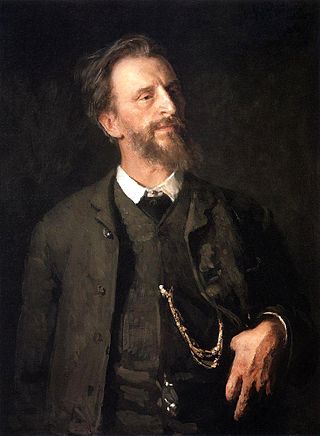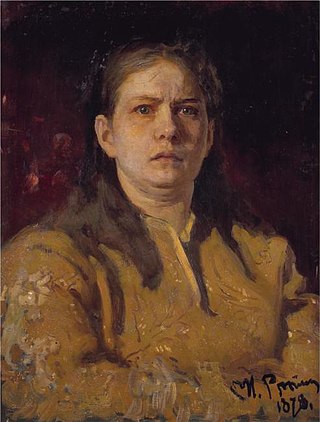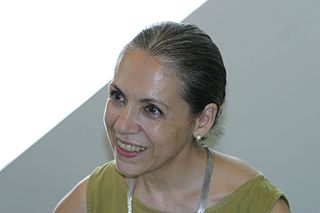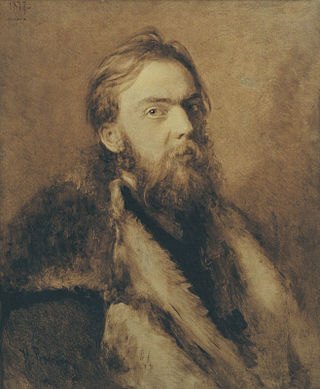Related Research Articles

Peredvizhniki, often called The Wanderers or The Itinerants in English, were a group of Russian realist artists who formed an artists' cooperative in protest of academic restrictions; it evolved into the Society for Travelling Art Exhibitions in 1870.

The Russian Academy of Arts, informally known as the Saint Petersburg Academy of Arts, was an art academy in Saint Petersburg, founded in 1757 by the founder of the Imperial Moscow University Ivan Shuvalov under the name Academy of the Three Noblest Arts. Elizabeth of Russia renamed it the Imperial Academy of Arts and commissioned a new building, completed 25 years later in 1789 by the Neva River. The academy promoted the neoclassical style and technique, and sent its promising students to European capitals for further study. Training at the academy was virtually required for artists to make successful careers.

Valentin Alexandrovich Serov was a Russian painter and one of the premier portrait artists of his era.

Konstantin Alekseyevich Korovin was a leading Russian Impressionist painter.
The Harriman Institute, the first academic center in the United States devoted to the interdisciplinary study of Russia and the Soviet Union, was founded at Columbia University in 1946, with the support of the Rockefeller Foundation, as the Russian Institute.

Grigoriy Grigorievich Myasoyedov was a Russian Realist painter associated with the Peredvizhniki movement.

Valentina Semyonova Serova was a Russian composer of German-Jewish descent. Her family had converted to Lutheranism before she was born.
Jeri Laber is one of the founders of Human Rights Watch, the largest human rights organization in the United States. She is the author and/or editor of dozens of Human Rights Watch reports and more than 100 articles on human rights issues published in The New York Times, The New York Review of Books and many other publications. Her memoir "The Courage of Strangers: Coming of Age with the Human Rights Movement" was published in 2002 by Public Affairs. She is co-author, with Barnett Rubin, of "A Nation is Dying: Afghanistan Under the Soviets," Northwestern University Press. Her novel, "The Russian Key," was published by Arcade in 2021.
John Newbold Hazard (1909–1995) was a leading American scholar of Soviet law and public administration. Hazard was one of the pioneers in the field of Sovietology, particularly in Soviet law, administration and politics.

Barge Haulers on the Volga or Burlaki is an 1870–1873 oil-on-canvas painting by artist Ilya Repin. It depicts 11 men physically dragging a barge on the banks of the Volga River. They are at the point of collapse from exhaustion, oppressed by heavy, hot weather.

Lynn Theresa Garafola is an American dance historian, linguist, critic, curator, lecturer, and educator. A prominent researcher and writer with broad interests in the field of dance history, she is acknowledged as the leading expert on the Ballets Russes de Serge Diaghilev (1909–1929), the most influential company in twentieth-century theatrical dance.

Padma Desai is an Indian-American development economist who was born and studied in India before completing a PhD at Harvard in 1960. She is the Gladys and Roland Harriman Professor Emerita of comparative economic systems and has been the director of the Center for Transition Economies at the Columbia University.
Kimberly Marten is an author and scholar specializing in international security, foreign policy, Russia, and environmental politics. She held the 5-year-term Ann Whitney Olin Professorship of Political Science at Barnard College from 2013 to 2018, and then returned to chair the Barnard Political Science Department for a second time from 2018-2021. She was the director of the Program on U.S.-Russia Relations at Columbia University’s Harriman Institute from 2015 to 2019, and the Harriman Institute published a profile of her career. She is a member of the Council on Foreign Relations and the International Institute for Strategic Studies, and a frequent media commentator.

Mykola Ivanovych Murashko was a Ukrainian painter, art teacher, art critic and art historian, who belonged to promoters of the Russian movement of Peredvizhniki; he was a student and successor of painter Adrian Prakhov at the St. Petersburg Academy of Arts, the founder and the first director of his own private drawing school in Kiev and memoirist.

Alexei Stepanovich Stepanov was a Russian genre painter, illustrator and art teacher. He was a member of the Peredvizhniki and a founder of the "Union of Russian Artists".
Rosalind Polly Blakesley is a prize-winning author, art historian and academic. She has taught art history at the University of Cambridge and been a Fellow of Pembroke College, Cambridge since 2002, and has been Professor of Russian and European Art since 2018. She previously worked at Queen's College, Oxford, the Russian Institute of Art History, Newcastle University, and the University of Kent.

Girl with Peaches is an 1887 painting by the Russian painter Valentin Serov.

Nina Simonovich-Efimova was a Russian artist, puppet designer and one of the first professional Russian puppeteers. Together with her husband Ivan Efimov she founded the tradition of Soviet puppet theater, acting as the driving force behind the Efimovs' presentations.

Marc Klionsky was a Russian-American artist who worked in New York City from his immigration in 1974 until his passing in 2017. Klionsky developed a style of American Realism uniquely defined by his classical training in the Soviet Union and his perspective of daily life in New York and America. Over the course of his career, Klionsky painted portraits of prominent world figures who shaped the 20th century. John Russell, art critic for The New York Times, described him as "a good man and a brave man and one of the most eloquent painters around. We need him" and as "one of the best portrait painters around."

The Revolt of the Fourteen was the refusal of 14 top students in the Imperial Academy of Arts of the Russian Empire to participate in a competition that was held on the 100th anniversary of the Academy on 9 November 1863. The revolt, which was led by the realist painter Ivan Kramskoi, was a response to the academy's refusal to give the competitors a free choice of art subject in the competition. The subsequent withdrawal of artists from the academy was the first demonstration by realist artists against the classical style that was popular in 19th-century Russia and is sometimes cited as the source of realism in Russian art.
References
- ↑ Elizabeth Kridl Valkenier. Harriman Institute. Retrieved 4 December 2017.
- ↑ Valkenier, Elizabeth. (1989) Russian Realist Art. The State and Society: The Peredvizhniki and Their Tradition. New York: Columbia University Press. p. xiii.
- ↑ Leigh on Blakesley and Samu, From Realism to the Silver Age: New Studies in Russian Artistic Culture: Essays in Honor of Elizabeth Kridl Valkenier Allison Leigh, H-Russia, H-Net, September 2016. Retrieved 6 December 2017.
- ↑ "Reviewed Work: Valentin Serov: Portraits of Russia's Silver Age by Elizabeth Kridl Valkenier", Frederick H. White, Canadian Slavonic Papers/Revue Canadienne des Slavistes , Vol. 45, No. 3/4 (September–December 2003), pp. 495-496. (subscription required)
- ↑ "Review: Valentin Serov: Portraits of Russia's Silver Age. By Valkenier Elizabeth Kridl." John Milner, Slavic Review , Volume 62, Issue 2 (June 2003), pp. 427-428. (subscription required)